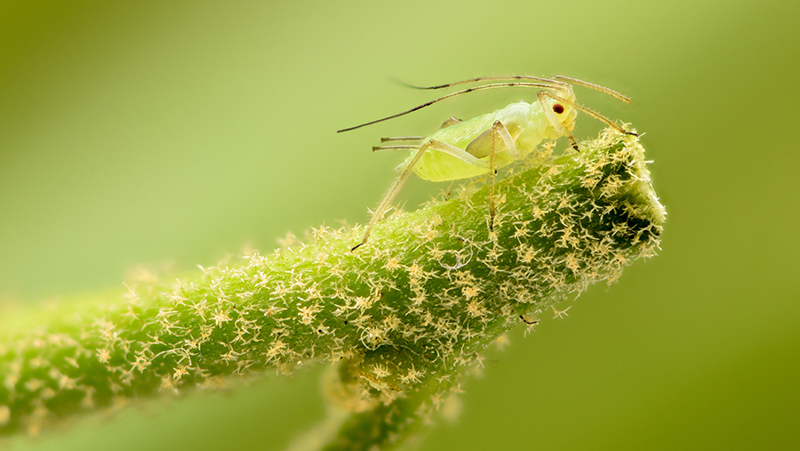Yates Account
Join now
Create a Yates account today!
Sign up to join the Yates Garden Club for monthly e-mails packed with seasonal inspiration, tips for success & exclusive promotions.
Plus if you’re a Garden Club member you can take part in the Yates Growing Community - a blog to share successes, get advice & win prizes in fun challenges along the way!

Forgot password
Enter the email address associated with your account, and we'll email you a new password.
Aphididae

What are Aphids?
Aphids are small pear-shaped insects, about 2–4mm long. You'll often see them swarming a plant in huge numbers. You may see miniature aphids in amongst them; these are immature nymphs (aphids can give birth to live young, which allows them to multiply really quickly). Small colonies increase rapidly in warm conditions, and large infestations can develop in a matter of days. Inspect your plants a couple of times a week as soon as the weather warms up, so you can keep aphids in check while populations are relatively small.
Aphids cause damage to plants directly through feeding, or indirectly as vectors of harmful viruses (which they inject into your plants in their saliva). They prefer to cluster on fresh young shoots and flower buds, or underneath older leaves.
There are 80+ different species of aphids in NZ; they all have different plant preferences, but between them they manage to attack fruit trees, citrus, roses, camellias and a wide range of vegetables.
Keep an eye out for natural predators, like ladybirds, or parasitic wasps, to help control aphids. These tiny wasps lay eggs inside the aphid, giving it a hard light brown shell like appearance. Ladybird larvae (which look like tiny bird droppings) are voracious eaters of aphids. Both of these predators will reduce aphid numbers rapidly once they arrive.

Here are some of the most commonly encountered pest aphids during spring:
- Black Citrus Aphids (Aphis citricidus) are glossy black or dark brown. You'll see them clustered in huge numbers on the growing tips of citrus trees in spring. These aphids are usually the culprits when leaf curl appears in citrus trees.
- Onion Aphids, AKA Black Aphids (Neotoxoptera formosana) are a serious pest of garlic, shallots, onions, chives, leeks and other alliums, causing yellowing, wilting and dehydration of leaves, and poor harvests.
- The Cabbage Grey Aphid (Brevicoryne brassicae) is greyish-green, with a powdery-looking waxy coating. It feeds on all types of brassica crops, usually hiding on the underside of leaves.
- The Green Peach Aphid (Myzus persicae) has a special liking for stonefruit, but it happily feeds on a wide range of vegetable crops (including brassicas) through summer and autumn.
- Woolly Apple Aphids (Eriosoma lanigerum) have a preference for apple and pear trees; they can distort new growth and damage buds, which inhibits the harvest. They are very distinctive because they cover themselves in a white fluffy woolly substance, which looks like clumps of cotton wool stuck to branches. The easiest way to control them is with a single winter spray of Yates Lime Sulfur, while the tree is leafless.
- The Rose Aphid (Macrosiphum rosae) is common pest of roses. Green or pinkish coloured aphids can be seen swarming on flower buds and tender growing tips.
- Strawberry Aphids (Chaetosiphon fragaefolii) are pale yellow in colour. These aphids spread strawberry mottle virus: a very damaging disease that stunts growth, yellows leaves and impedes fruiting. During spring they're often found on the underside of strawberry leaves, so good spray coverage is important to control them effectively.
- The Melon Aphid (Aphis gossypii) prefers to feed on curcubits, like watermelons, cucumbers, pumpkin, luffa and zucchini.
Life Cycle
Aphids typically develop through a life cycle of rapid metamorphosis. Many aphid species are capable of reproducing without males (this is called parthenogenesis). This explains why aphid colonies can increase in size so rapidly; during warm weather females mostly birth live young, without needing to mate. In warmer climates, they can do this all year round. In cooler climates, aphids will overwinter by mating and laying eggs that hatch in spring.
Aphids typically pass through 4 nymph stages (instars) before the adult stage. As they moult, they leave behind their old skin casts, which are visible in aphid colonies as white objects. Aphid life cycles can be completed in 10 to 14 days in warm weather, and there can be more than 20 generations per year, depending on the climate and the species.
Adult aphids without wings are the norm when the colony isn’t overcrowded. When a colony needs to migrate from an over-wintering site, or from drying plants, or when conditions become too crowded, winged adult aphids develop; allowing them to move to new host plants.

Symptoms
Leaves can be twisted and distorted. New growth may be stunted, and is often covered in dense clusters of feeding aphids. Buds may fail to open. You may notice that fruit fails to set, or experience fruit drop.
Leaves may be covered in unsightly white aphid skin casts.
Because aphids excrete a substance called honeydew, this provides an ideal environment for Sooty Mould fungus to grow. Removing the aphids that cause the honeydew will usually solve the sooty mould problem as well.
Honeydew is also very attractive to ants, so they're often visible around aphid infestations. Fascinatingly, ants are known to protect aphids from predators, a little bit like farmers protect cows...so the ants can harvest the honeydew!
Plants impacted
- Citrus
- Fruit Trees
- Berries
- Vegetables
- Roses
- Ornamentals
















Share
Share this article on social media